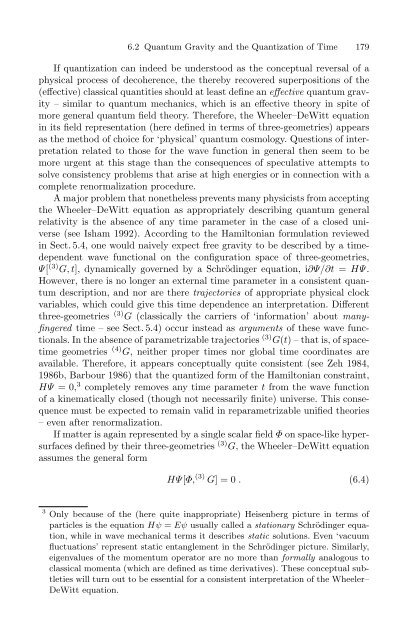The Physical Basis of The Direction of Time (The Frontiers ...
The Physical Basis of The Direction of Time (The Frontiers ...
The Physical Basis of The Direction of Time (The Frontiers ...
Create successful ePaper yourself
Turn your PDF publications into a flip-book with our unique Google optimized e-Paper software.
6.2 Quantum Gravity and the Quantization <strong>of</strong> <strong>Time</strong> 179<br />
If quantization can indeed be understood as the conceptual reversal <strong>of</strong> a<br />
physical process <strong>of</strong> decoherence, the thereby recovered superpositions <strong>of</strong> the<br />
(effective) classical quantities should at least define an effective quantum gravity<br />
– similar to quantum mechanics, which is an effective theory in spite <strong>of</strong><br />
more general quantum field theory. <strong>The</strong>refore, the Wheeler–DeWitt equation<br />
in its field representation (here defined in terms <strong>of</strong> three-geometries) appears<br />
as the method <strong>of</strong> choice for ‘physical’ quantum cosmology. Questions <strong>of</strong> interpretation<br />
related to those for the wave function in general then seem to be<br />
more urgent at this stage than the consequences <strong>of</strong> speculative attempts to<br />
solve consistency problems that arise at high energies or in connection with a<br />
complete renormalization procedure.<br />
A major problem that nonetheless prevents many physicists from accepting<br />
the Wheeler–DeWitt equation as appropriately describing quantum general<br />
relativity is the absence <strong>of</strong> any time parameter in the case <strong>of</strong> a closed universe<br />
(see Isham 1992). According to the Hamiltonian formulation reviewed<br />
in Sect. 5.4, one would naively expect free gravity to be described by a timedependent<br />
wave functional on the configuration space <strong>of</strong> three-geometries,<br />
Ψ[ (3) G, t], dynamically governed by a Schrödinger equation, i∂Ψ/∂t = HΨ.<br />
However, there is no longer an external time parameter in a consistent quantum<br />
description, and nor are there trajectories <strong>of</strong> appropriate physical clock<br />
variables, which could give this time dependence an interpretation. Different<br />
three-geometries (3) G (classically the carriers <strong>of</strong> ‘information’ about manyfingered<br />
time – see Sect. 5.4) occur instead as arguments <strong>of</strong> these wave functionals.<br />
In the absence <strong>of</strong> parametrizable trajectories (3) G(t) – that is, <strong>of</strong> spacetime<br />
geometries (4) G, neither proper times nor global time coordinates are<br />
available. <strong>The</strong>refore, it appears conceptually quite consistent (see Zeh 1984,<br />
1986b, Barbour 1986) that the quantized form <strong>of</strong> the Hamiltonian constraint,<br />
HΨ =0, 3 completely removes any time parameter t from the wave function<br />
<strong>of</strong> a kinematically closed (though not necessarily finite) universe. This consequence<br />
must be expected to remain valid in reparametrizable unified theories<br />
– even after renormalization.<br />
If matter is again represented by a single scalar field Φ on space-like hypersurfaces<br />
defined by their three-geometries (3) G, the Wheeler–DeWitt equation<br />
assumes the general form<br />
HΨ[Φ, (3) G]=0. (6.4)<br />
3 Only because <strong>of</strong> the (here quite inappropriate) Heisenberg picture in terms <strong>of</strong><br />
particles is the equation Hψ = Eψ usually called a stationary Schrödinger equation,<br />
while in wave mechanical terms it describes static solutions. Even ‘vacuum<br />
fluctuations’ represent static entanglement in the Schrödinger picture. Similarly,<br />
eigenvalues <strong>of</strong> the momentum operator are no more than formally analogous to<br />
classical momenta (which are defined as time derivatives). <strong>The</strong>se conceptual subtleties<br />
will turn out to be essential for a consistent interpretation <strong>of</strong> the Wheeler–<br />
DeWitt equation.



![arXiv:1001.0993v1 [hep-ph] 6 Jan 2010](https://img.yumpu.com/51282177/1/190x245/arxiv10010993v1-hep-ph-6-jan-2010.jpg?quality=85)


![arXiv:1008.3907v2 [astro-ph.CO] 1 Nov 2011](https://img.yumpu.com/48909562/1/190x245/arxiv10083907v2-astro-phco-1-nov-2011.jpg?quality=85)








![arXiv:1002.4928v1 [gr-qc] 26 Feb 2010](https://img.yumpu.com/41209516/1/190x245/arxiv10024928v1-gr-qc-26-feb-2010.jpg?quality=85)
![arXiv:1206.2653v1 [astro-ph.CO] 12 Jun 2012](https://img.yumpu.com/39510078/1/190x245/arxiv12062653v1-astro-phco-12-jun-2012.jpg?quality=85)
